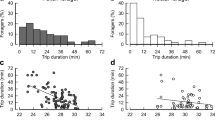Summary
Temperature regulation inBombus terricola was investigated in the field in relation to foraging energetics on flowers differing widely in morphology and nectar contents.
-
1.
While foraging for nectar fromAsclepias syriaca mean thoracic temperature (TTh) was relatively independent from ambient thermal conditions, ranging from 35.2 °C in shade at 12 °C, to 37.5 °C in sunshine at 28 °C (Fig. 1).
-
2.
While foraging for pollen fromSolanum dulcamara TTh was also regulated near 36 °C (Fig. 2).
-
3.
In contrast, mean TTh ofB. terricola foraging fromSpiraea latifolia andSolidago canadensis varied nearly directly with ambient thermal conditions (Figs. 4 and 5).
-
4.
Abdominal temperature varied nearly directly with TA regardless of whether or not TTh was stabilized (Figs. 1 and 4).
-
5.
At TA<21 °C in shade many of the nectar foragers onSolidago canadensis andSpiraea latifolia, having a TTh < 29 °C, were incapable of immediate flight. However, the TTh of pollen gatherers at the same TA (Table 1) was higher (p < 0.01), and these bees were always capable of immediate flight.
-
6.
The energetic costs for temperature regulation during foraging at different TA, and the energetic gains that might be derived are discussed (see Figs. 7 and 8) in relation to the geometry of nectar distribution in space, and in relation to nectar abundance.
Similar content being viewed by others
References
Baker, H. G., Hurd, P. D. Jr.: Intrafloral ecology. Ann. Rev. Entomol.13, 385–414 (1968).
Bartholomew, G. A.: Body temperature and energy metabolism. In: Animal function: principles and adaptations. Ed. M. S. Gordon, p. 347–354. New York: Macmillan 1968.
Bastian, J., Esch, H.: The nervous control of the indirect flight muscles of the honey bee. Z. vergl. Physiol.67, 307–324 (1970).
Beutler, R.: Über den Blutzucker der Bienen. Z. vergl. Physiol.24, 71–115 (1937).
Brian, A. D.: Division of labour and foraging inBombus agrorum Pabricius. J. anim. Ecol.21, 223–240 (1952).
Brian, A. D.: Differences in the flowers visited by four species of bumblebees and their causes. J. anim. Ecol.26, 71–98 (1957).
Bruggemann, P. F.: Insects and environments of the high Arctic. 10th Int. Congr. Entomol., 1956, vol.1, p. 695–702 (1958).
Butler, C. G.: The influence of various physical and biological factors of the environment on honeybee activity. An examination of the relationship between activity and nectar concentration and abundance. J. exp. Biol.21, 5–12 (1945).
Esch, H.: Über die Körpertemperaturen und den Wärmehaushalt vonApis mellifica. Z. vergl. Physiol.43, 305–335 (1960).
Esch, H.: Über den Zusammenhang zwischen Temperatur, Aktionspotentialen und Thoraxbewegungen bei der Honigbiene (Apis mellifica L.). Z. vergl. Physiol.48, 547–551 (1964).
Faegri, K., van der Pijl, L.: The principles of pollination ecology. Toronto-Oxford-London-Edinburgh-New York-Paris-Braunschweig: Pergamon Press 1966.
Free, J. B.: The collection of food by bumblebees. Ins. Soc.2, 303–311 (1955).
Grant, V.: Pollination systems as isolating mechanisms in angiosperms. Evolution3, 82–97 (1949).
Heinrich, B.: Thoracic temperature regulation in the sphinx moth,Manduca sexta. Parts I and II. J. exp. Biol.54, 141–166 (1971a).
Heinrich, B.: Temperature regulation in the bumblebee,Bombus vagans: a field study. Science175, 185–187 (1972).
Hulkkonen, O.: Zur Biologie südfinnischer Hummeln. Ann. Univ. Abo. (Turku), Ser. A3, 1–18 (1928).
Krogh, A., Zeuthen, E.: The mechanism of flight preparation in some insects. J. exp. Biol.18, 1–10 (1941).
Linsley, E. G., Cazier, M. A.: Further observations on bees which take pollen from plants of the genusSolanum. Pan-Pacific Entomol.39, 1–18 (1963).
Lovell, J. H.: The flower and the bee. London: Constable & Co., Ltd. 1919.
Manning, A.: Some aspects of the foraging behavior of bumble-bees. Behavior9, 164–201 (1954).
Medler, J. T.: Bumblebee ecology in relation to the pollination of alfalfa and red clover. Ins. Soc.4, 245–252 (1957).
Michener, C. D.: An interesting method of pollen collecting by bees from flowers with tubular anthers. Rev. Biol. Trop.10, 167–175 (1962).
Núñez, J. H.: The relationship between sugar flow and foraging recruiting behavior of honey bees (Apismellifera L.) Anim. Behav.18, 527–538 (1970).
Oertel, E.: Honeyflow from goldenrod in relation to temperature. J. econ. Entomol.25, 520–524 (1932).
Pellett, F. C.: American honey plants, 4th ed. New York: Orange Judd Publ. Co., Inc. 1947.
Scholze, E., Pichler, H., Heran, H.: Zur Entfernungsschätzung der Bienen nach dem Kraftaufwand. Naturwissenschaften51, 69–70 (1964).
Sotavalta, O.: On the thoracic temperature of insects in flight. Ann. Zool. Soc. “Vanamo”16, 1–22 (1954).
Stebbins, G.: Adaptive radiation of reproductive characteristics in angiosperms. I. Pollination mechanisms. Ann. Rev. Ecol. and System.1, 307–326 (1970).
Vansell, G. H.: Relation between nectar concentration in fruit blossoms and the visits of honeybees. J. econ. Entomol.27, 943–945 (1934).
Wille, A.: Behavioral adaptations of bees for pollen collecting fromCassia flowers. Rev. Biol. Trop.11, 205–210 (1963).
Wykes, G. R.: The sugar contents of nectars. Biochem. J.53, 294–296 (1953).
Author information
Authors and Affiliations
Additional information
I thank Mr. and Mrs. Gerd H. Heinrich, Dryden, Maine, who made field studies at the farm truly pleasurable, and the neighbors, who were goodnaturedly tolerant. I profited from comments and criticisms generated during seminars of various aspects of this work delivered at: The Department of Entomology and Parasitology, Berkeley; the Department of Zoology, Berkeley; Dr. G. A. Bartholomew's Ecological Physiology seminar at UCLA; Dr. P. H. Raven's Population Biology seminar at Stanford University.
Rights and permissions
About this article
Cite this article
Heinrich, B. Energetics of temperature regulation and foraging in a bumblebee,Bombus terricola kirby. J. Comp. Physiol. 77, 49–64 (1972). https://doi.org/10.1007/BF00696519
Received:
Issue Date:
DOI: https://doi.org/10.1007/BF00696519




